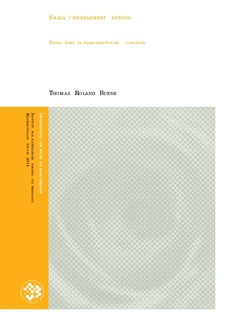| dc.description.abstract | Denne oppgaven tar for seg silikas innvirkning på fiberbetong med tanke på fiberens
heftkapasitet, betongens tøyelighet, trykk- og strekkfasthet.
Oppgaven er inndelt i to deler:
1. En litteraturstudie tar for seg plast- og stålfibres ulike egenskaper i de forskjellige
fasene av betongens utvikling fra plastisk til herdet. Det er sett på hvordan
belastningen overføres fra pasta til fiber, og fiberens belastningsforløp fra første
belastning til den er helt løsrevet fra den omsluttende betongpastaen. Tidligere forsøk
som er gjort på området, og som kan bidra til å belyse spørsmålene rundt
problemstillingen, er presentert og diskutert.
2. Laboratoriearbeid utført på UMB's betonglabb som gikk ut på å støpe åtte ulike
prøveserier, tilsammen 72 terninger, med ulik tilsetting av fiber og silika og
forskjellig herdetid. Terningene ble trykktestet for å undersøke de ulike tilsetningenes
påvirkning av trykkfastheten gjennom herdetiden.
På grunnlag av forsøksresultatene og litteraturstudiet ble det trukket følgende slutninger:
1. Overgangssonen mellom fiber og pasta får økt kontaktflate ved tilsetting av silika på
grunn av at pastaen forfines av de små silikakornene. Den økte kontaktflaten
resulterer i økt heftkapasitet.
2. Tilsetting av silika kan, på grunn av filler-effekten, gi et ekstra bidrag til
trykkfastheten ved at betongen blir mer kompakt rundt fibre som ligger tett.
3. For høy konsentrasjon av fiber i betongen kombinert med lavt v/c-tall kan føre til lav
grad av kompakthet og dermed svekket trykkfasthet.This thesis investigates the effect of silica fume on fibre-reinforced concrete with respect to
fibre/matrix bonding, concrete ductility and compressive and tensile strengths.
The thesis is divided into two parts:
1. A literature study that investigates synthetic and steel fibre's properties in the different
phases of the concrete curing. The focus is on how stress is transferred from the
matrix to the fibre, and the behavior of the fibre from the first impact to the total
separation of the fibre from the concrete. Former experiments on the subject that can
help clarifying issues surrounding the problem has been presented and discussed.
2. Laboratory experiments conducted at the Norwegian University of Life Sciences
(UMB) included the casting of eight different batches, a total of 72 cubes, containing
different amounts of fibre and silica fume and subject to varying curing time. The
cubes were compression tested to examine the influence of different additives on the
compressive strength throughout the curing time.
Based on the experimental results and the literature study the following conclusions were
drawn:
1. The interfacial transition zone (ITZ) between the fibre and matrix is increased by the
addition of silica fume as a result of the matrix being refined by the small grains. The
increased ITZ results in a stronger fibre-matrix bond.
2. The addition of silica fume can, because of the filler-effect, provide an additional
contribution to the compressive strength due to a more compacted matrix around
fibres that are closely spaced.
3. A too high concentration of fibres in the concrete combined with a low w/c-ratio can
result in a low degree of compacting and thus lowered compressive strength. | no_NO |
